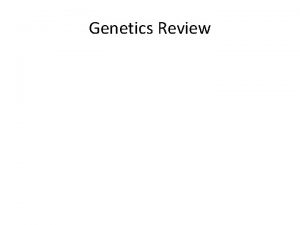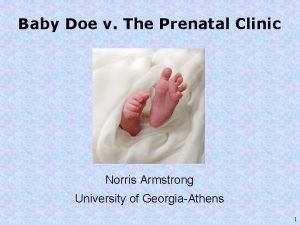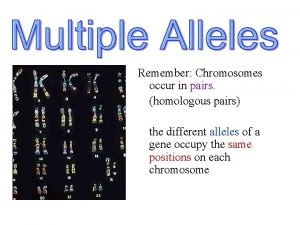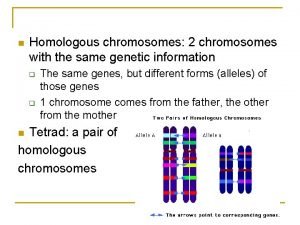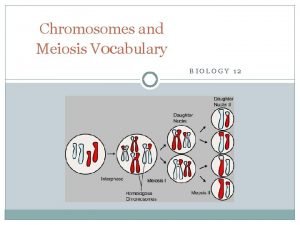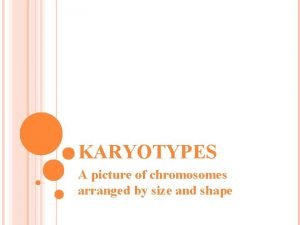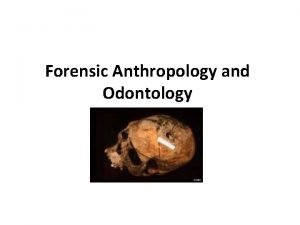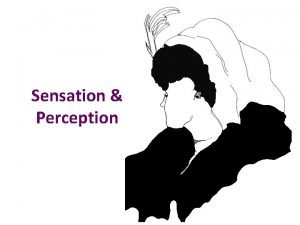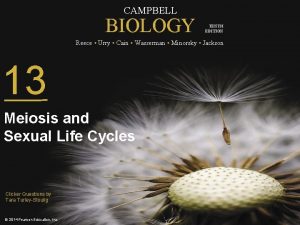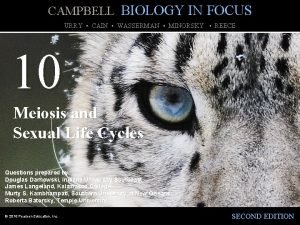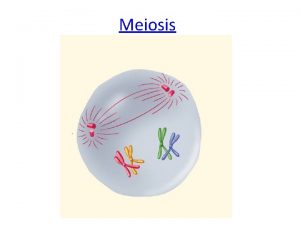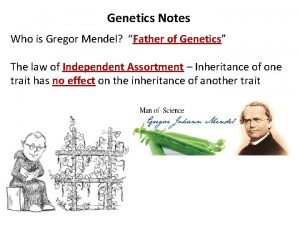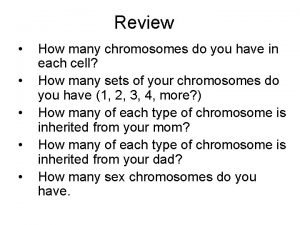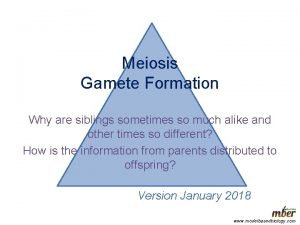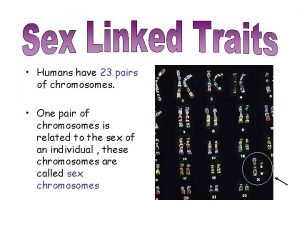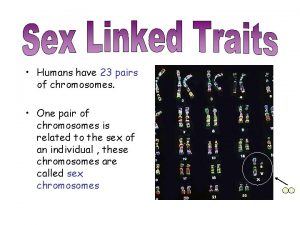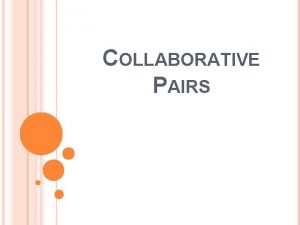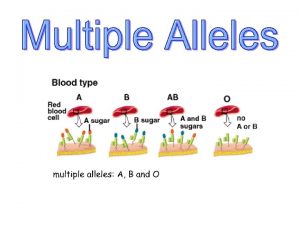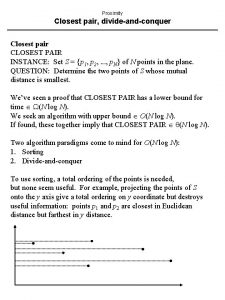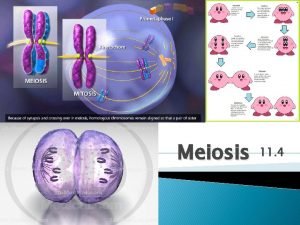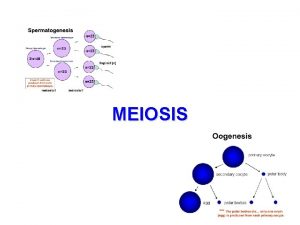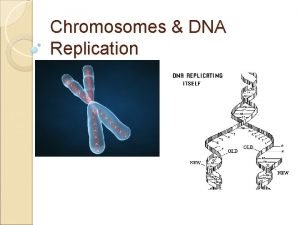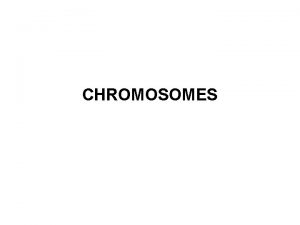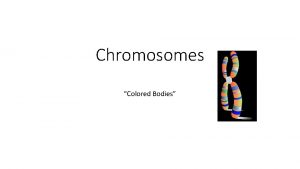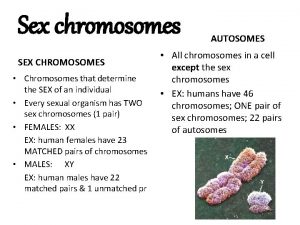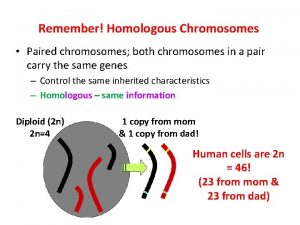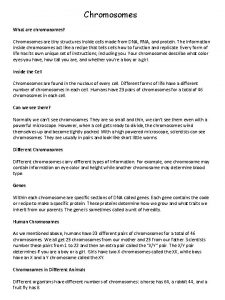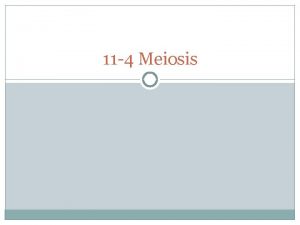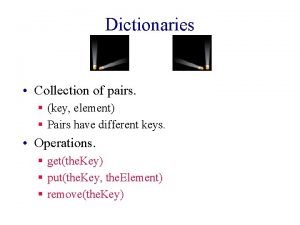Humans have 23 pairs of chromosomes One pair




















- Slides: 20

• Humans have 23 pairs of chromosomes. • One pair of chromosomes is related to the sex of an individual , these chromosomes are called sex chromosomes

• The other 22 pairs of chromosomes are called autosomes (1 -22)


• Genes that are located on the X chromosome are called sex-linked genes. • Traits determined by sex-linked genes are called sex-linked traits (c = colorblind, C = normal) Ex. Color blindness female Xc Xc male Xc Y

• Sex linked traits are recessive, this means both x chromosomes must have the gene in order for the trait to be expressed.

• If only one x chromosome is present (in males)and has the sex linked gene, then the trait will be expressed

• A carrier is a person that has the trait on only one chromosome and does not express the trait. Carriers of sex linked traits are always women. (C= normal, c= colorblind) Ex. Color blind carrier XC Xc


• A colorblind male marries a normal female. What are the offspring genotypes and phenotypes? (C = normal, c = colorblind) Xc XC XC Y

• A normal male (not colorblind) marries a carrier. What are the offspring genotypes and phenotypes? XC Y XC Xc

• A normal male (not colorblind) marries a colorblind female. What are the offspring genotypes and phenotypes? XC Y Xc Xc

• Hemophilia is characterized by uncontrolled bleeding • It is a sex linked disorder caused by errors in the DNA that codes for the proteins involved in clotting

Linked Genes • Some traits seem to be inherited together. – Example Gray bodied fruit flies also have long wings. Genes that tend to be inherited together are on the same chromosome and called Linked Genes.

Mutations • Germ-Cell Mutations are changes in your sex cells. They do not affect the person, but can be passed on. • Somatic- Cell Mutations are changes to your body cells and can affect you.

Mutations • A Chromosome Mutation is a change in the structure of a chromosome or the loss or gain of a chromosome. • Four main types of mutation. – Deletion – Inversion – Translocation – Duplication

Mutations • Deletion: The loss of a piece of a chromosome due to breakage. • Inversion: a chromosomal segment breaks off flips around backwards and reattaches.

Mutations • Translocation: A piece of a chromosome breaks off and reattaches to a non homologous chromosome. • Duplication: A certain section of the chromosome gets copied twice.

Mutations • Another mutation that can occur is when sister chromatids fail to separate correctly during meiosis. • This is called Nondisjunction.

Chromosome Map • Scientists are able to locate individual genes on a chromosome. • Due to chromosome mapping scientists are able to tell if certain genes are damaged and the resulting disorder.

Pedigrees • Some Mutations are inherited. • Scientists can use Pedigrees to show a trait is inherited over generations.
 How many pairs of chromosomes
How many pairs of chromosomes How many chromosomes do humans have
How many chromosomes do humans have How many chromosomes do humans have
How many chromosomes do humans have How many chromosomes do humans have
How many chromosomes do humans have Alel ganda
Alel ganda What is homologous chromosome
What is homologous chromosome How many pairs of chromosomes
How many pairs of chromosomes Zwk99035 key
Zwk99035 key Python unordered pair
Python unordered pair Rolling pair is higher pair
Rolling pair is higher pair Vsepr theory
Vsepr theory Male and female skeleton differences
Male and female skeleton differences How many senses do humans have
How many senses do humans have Privet shrubs and humans each have a diploid number of 46
Privet shrubs and humans each have a diploid number of 46 Privet shrubs and humans each have a diploid number of 46
Privet shrubs and humans each have a diploid number of 46 What are vertebrochondral ribs
What are vertebrochondral ribs Gametes are produced by the process of
Gametes are produced by the process of What happens if you have 45 chromosomes
What happens if you have 45 chromosomes Ispindle
Ispindle How many chromosomes do prokaryotes have
How many chromosomes do prokaryotes have Gamete formation
Gamete formation
